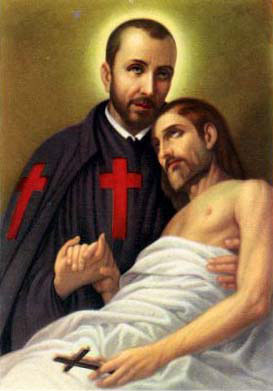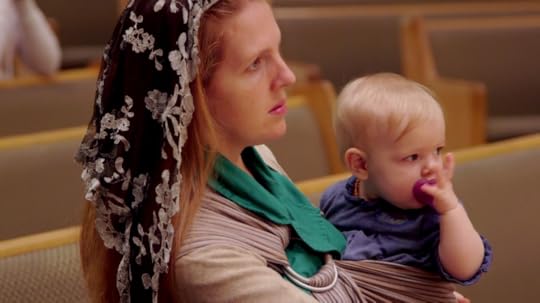Brandon Vogt's Blog, page 15
July 23, 2015
The ONE Question Every Catholic Today Needs to Ask
New research shows that 7% of Catholics contribute 80% of all donations and volunteer hours. It’s easy to cater everything to this group. We know they’ll sign-up, they’ll show up, they’ll subscribe, they’ll buy books, they’ll give.
But every Catholic needs to ask this question: what am I doing to reach the other 93%?
In the press conference announcing Fr. Robert Barron as a new auxiliary bishop in Los Angeles, he said, “The most significant challenge facing the Catholic Church today is the attrition of our own people.”
So what am I doing to reach the large majority of inactive Catholics who aren’t frequenting our institutions, who don’t know or care much about Catholicism, and who who have drifted away from the sacraments?
What about those even beyond the 93% who have never identified as Catholic—perhaps they identify as “atheist” or “none”—for whom Catholicism is not even on the radar?
Am I truly engaging them or am I just catering to the already-engaged 7%?
The latter is certainly easier. You’ll receive more praise. You’ll get more pageviews and purchases. It’s undoubtably more comfortable.
This is why there are tons of resources for the 7%. The typical parish has scores of ministries, almost all of which exist for the 7%. The large majority of Catholic books and newspapers are written for the 7%. Almost all Catholics websites are run by and for the 7%.
But the New Evangelization is not fundamentally about the 7%. It’s about the 93%, about drawing them home.
We can’t ignore the 7%—they need evangelizing, too. But the mission of the Church is essentially outward. Evangelistically, it’s centrifugal, not centripetal. It’s about the 93% more than the 7%.
Every Catholic parish, ministry, blogger, and newspaper needs to constantly ask this question: what am I doing for the 93%?
Am I just giving lip service to them or am I structuring my entire work around their conversion?
Am I looking even beyond the 93%, to those on the far end of the religious bell curve?
These should be the driving questions today.
(Note: I’m not exempting myself from these questions. I continually ask them of myself and I’m not always happy with the answers. But these are the questions we need to be asking.)
The post The ONE Question Every Catholic Today Needs to Ask appeared first on Brandon Vogt.





July 14, 2015
Learning from a Model of Mercy
Today we continue our regular series called “Learning from the Saints.” Our guide is expert Bert Ghezzi, a dear friend of mine and the author of numerous books including Voices of the Saints, Saints at Heart, and Discover Christ: Developing a Personal Relationship with Jesus.
His more recent books are The Power of Daily Mass and The Heart of Catholicism. You can learn more about Bert and his work at BertGhezzi.com.
Today, Bert profiles St. Camillus de Lellis, the patron of nurses and the sick.
St. Camillus was a giant for his times, standing 6 feet 6 inches tall. He also became a spiritual giant through his unselfish service of the sick.
 At 17 Camillus went with his father to fight against the Turks, and while at war his leg became infected with a serious disease that remained with him for life. He was a rebellious youth, with an addiction to gambling that nearly destroyed him. By age 24 he had literally lost his shirt to gambling. At 25, however, while working at a Capuchin monastery, he responded to a friar’s preaching with radical repentance. He turned his life to Christ and wanted to become a Capuchin, but could not be admitted to the order because of his diseased leg. So he went to work at a hospital for the incurably sick in Rome where he had spent some time when his leg was first infected. There he devoted himself entirely to the care of the sick. The hospital administrators were so impressed with his charity and ability that they appointed him bursar. And to prepare himself to assist the sick spiritually he became a priest.
At 17 Camillus went with his father to fight against the Turks, and while at war his leg became infected with a serious disease that remained with him for life. He was a rebellious youth, with an addiction to gambling that nearly destroyed him. By age 24 he had literally lost his shirt to gambling. At 25, however, while working at a Capuchin monastery, he responded to a friar’s preaching with radical repentance. He turned his life to Christ and wanted to become a Capuchin, but could not be admitted to the order because of his diseased leg. So he went to work at a hospital for the incurably sick in Rome where he had spent some time when his leg was first infected. There he devoted himself entirely to the care of the sick. The hospital administrators were so impressed with his charity and ability that they appointed him bursar. And to prepare himself to assist the sick spiritually he became a priest.
Camillus was appalled by conditions at the hospital and began to surround himself with other young men who were committed to serve the sick. With the support of his adviser, St. Philip Neri, he founded in 1585 the Servants of the Sick, a congregation of male nurses. They pledged themselves to care for the plague-ridden, the sick in hospitals and at home and prisoners. Camillus and his brothers founded and staffed eight hospitals in Italy. In 1595 and 1601 some of them attended the wounded on battlefields in Hungary and Croatia, the first recorded examples of military ambulance units.
Sick and in pain most of the time Camillus himself served without complaint. A member of his order wrote this moving description of the saint:
“I cannot get it out my mind, that when he was attending on a sick person, he looked like a hen with her chickens or like a mother at the bedside of her sick child. For, as if his arms and hands were not enough for the expressions of his affection, he might generally be seen bent over the poor man, as though he wished to communicate to him his heart, his breath, and his very soul.
“Before leaving the bed, too, he would keep smoothing the pillow and gently removing the bedclothes from the sick man’s face and feet and sides. And as if attracted by some invisible lodestone, he seemed as though he could not force himself away. But he hovered about the bed, inquiring how the patient felt, whether he wanted anything else, and giving him some maxim to meditate on for the good of his soul.
“I know not what more the most affectionate mother could have done for her only child in his sickness. No one who did not know the holy father would ever have thought that he had gone to the hospital to serve all the sick without distinction. They would have supposed that all his care was wrapped up in the life of that one poor man and that he had nothing else in the world to think about.”
Camillus championed some avant-garde medical practices, insisting, for example, on proper diet, fresh air and isolation of infected patients. He died in 1614.
Christ’s words, “I was ill and you visited me,” seems to have been engraved on St. Camillus’ heart. He repeated this divine slogan daily, encouraging his brothers to love the sick without thought of themselves.
Adapted from Bert Ghezzi, Voices of the Saints (Loyola Press)
(Image Credit: Catholic.org)
Read more from Bert at his website www.BertGhezzi.com, or check out his many books on Amazon.
The post Learning from a Model of Mercy appeared first on Brandon Vogt.





July 10, 2015
Book Giveaway (10 copies): “A Hobbit, a Wardrobe, and a Great War”
“Find out how much God has given you and from it take what you need; the remainder is needed by others.” – St. Augustine
Since I’ve built up a large collection of extra books and resources, every week I give some away absolutely free, no strings attached. Each giveaway lasts seven days with a new one beginning every Friday. You can enter any time during the week. Check out my past giveaways here.
Thanks to Thomas Nelson, today I’m giving away TEN copies of a new book on the Inklings, A Hobbit, a Wardrobe, and a Great War.
A Hobbit, a Wardrobe, and a Great War: How J.R.R. Tolkien and C.S. Lewis Rediscovered Faith, Friendship, and Heroism in the Cataclysm of 1914-1918
by Pope Francis
Thomas Nelson, 256 pages, hardcover
 The untold story of how the First World War shaped the lives, faith, and writings of J.R.R. Tolkien and C.S. Lewis.
The untold story of how the First World War shaped the lives, faith, and writings of J.R.R. Tolkien and C.S. Lewis.
The First World War laid waste to a continent and permanently altered the political and religious landscape of the West. For a generation of men and women, it brought the end of innocence—and the end of faith. Yet for J.R.R. Tolkien and C.S. Lewis, the Great War deepened their spiritual quest. Both men served as soldiers on the Western Front, survived the trenches, and used the experience of that conflict to ignite their Christian imagination. Had there been no Great War, there would have been no Hobbit, no Lord of the Rings, no Narnia, and perhaps no conversion to Christianity by C.S. Lewis.
Unlike a generation of young writers who lost faith in the God of the Bible, Tolkien and Lewis produced epic stories infused with the themes of guilt and grace, sorrow and consolation. Giving an unabashedly Christian vision of hope in a world tortured by doubt and disillusionment, the two writers created works that changed the course of literature and shaped the faith of millions. This is the first book to explore their work in light of the spiritual crisis sparked by the conflict.
I’m using Rafflecopter to help with the giveaway, which is cool because it allows you multiple entries for commenting, posting on Facebook, sharing on Twitter, etc. Click below to enter:
(If you’re reading this through email or RSS and don’t see the giveaway widget, click here.)
By entering this giveaway you agree to occasionally receive email updates from me—no spam, just updates about free books, cool links, and exciting news.
The winner(s) will be randomly selected next Friday and the books will be sent out, free of charge, shortly thereafter.
In the future I’ll be giving away more books and resources, sometimes multiple items per giveaway! So subscribe via feed reader or email to ensure you never miss your chance to win.
(Since I’m covering the shipping costs, only residents within the continental United States are eligible to win.)
The post Book Giveaway (10 copies): “A Hobbit, a Wardrobe, and a Great War” appeared first on Brandon Vogt.





July 8, 2015
[Video] How My Family Dresses for Mass
When my friend Eric Coughlin from Two Sense Films emailed me describing his new project, I thought it was a great idea. He wanted to create a short movie on dressing respectfully for Mass. His last film on altar servers was fantastic so I knew this would be another winner.
Then Eric asked if my family wanted to participate. I told him we would be honored. But I quickly added that, with four kids six and under, getting everyone ready for Mass often resembles a hostage negotiation. He said that was fine. Eric came over early one morning, filmed us getting ready, accompanied us to Mass, and the kids had a blast.
This morning he released the finished project. Please watch and share it around!
If you can’t see this video in your RSS reader or email, then click here.
Most people put little thought into dressing for Mass. When I was Protestant, the overarching message I heard was, “Come as you are! God doesn’t care what clothes you wear. He just wants you!” But over time, I discovered this was only a half-truth. Of course God loves you just as you are—that’s the only “you” that exists! And of course God would prefer you in a tank-top and sandals than not at all.
But the more I reflected, the more sure I became that what you wear matters. This is the case in every other meaningful area of life. For example, few bosses say to their employees, “Come as you are! Pajamas, muscle shirts, tube tops—it doesn’t matter!” No bride I know would say to her fiancée, “Come as you are to the wedding! I really don’t care what you wear.”
How you dress matters. There are at least two reasons why. First, because of what it says to others. Dressing nicely communicates respect and honor. When you dress specially for Mass, you’re telling God, “You are worth the effort; you deserve my best.” It tells your fellow worshippers, “I take Mass seriously; it’s not just one casual event among many for me.”
Second, dressing respectfully changes your interior orientation. I’ve found that when I pull on a suit and tie, my thoughts, speech, and general approach to the world all change. I become more gentlemanly. I’m more serious than silly. I’m better able to focus, display reverence, and sink into prayer. That’s why I’m convinced dressing up is a spiritual discipline. (My friend Jen Fulwiler reflected on similar experiences: “How Changing What I Wear Changed My Approach to Mass”.)
We all know that fewer people today are dressing respectfully at Mass. Visit the average service at your average parish and you’ll see the whole spectrum of attire, from prim and proper to scandalous and sulky.
But imagine if even a small percentage of Catholics decided to dress more respectfully each Sunday. Imagine how the atmosphere would instantly change. Imagine what our children would think, how they would see the Mass. Imagine how it would affect the prayer lives of people seeking deeper experiences. The spiritual fruit would be remarkable.
If you want to help bring on this shift, first commit to dressing more reverently yourself. Take the time and effort to dress better next Sunday. Then help your kids do the same. Finally, be sure to share Eric’s excellent video.
What do you typically wear to Mass?
The post [Video] How My Family Dresses for Mass appeared first on Brandon Vogt.





June 30, 2015
C.S. Lewis for the Digital Age: An Interview with Dr. Michael Ward
Today I have the pleasure of talking with one of my favorite people, Dr. Michael Ward, about a mutual third friend, C.S. Lewis.
Michael has been described by N.T. Wright as “the foremost living C.S. Lewis scholar”. He is the author of the groundbreaking study of Lewis’ writings, Planet Narnia: The Seven Heavens in the Imagination of C.S. Lewis (Oxford University Press, 2008) and also co-edited The Cambridge Companion to C.S. Lewis (Cambridge University Press, 2010).
 More recently, Michael has contributed essays to two new books, C. S. Lewis and His Circle: Essays and Memoirs from the Oxford C.S. Lewis Society (Oxford University Press, 2015) and Women and C.S. Lewis (Lion Hudson, 2015).
More recently, Michael has contributed essays to two new books, C. S. Lewis and His Circle: Essays and Memoirs from the Oxford C.S. Lewis Society (Oxford University Press, 2015) and Women and C.S. Lewis (Lion Hudson, 2015).
From 1996 to 1999, Michael was resident warden and curator of The Kilns, Lewis’ Oxford home. More recently, he was responsible for securing a memorial to C.S. Lewis in Poets’ Corner at Westminster Abbey.
He works as a senior research fellow at Blackfriars Hall (University of Oxford) and holds a doctorate in divinity from the University of St. Andrews. He lectures internationally on Lewis, J.R.R. Tolkien, and Christian apologetics.
After serving as an Anglican priest for many years, including a chaplaincy to St. Peter’s College at Oxford, he converted to Catholicism in 2012.
Today we’re discussing one of the most exciting developments ever to hit the C.S. Lewis world: the launch of the new Verbum C.S. Lewis Collection.
For the first time ever, you can get Lewis’ greatest works all in one place. The collection includes thirty volumes and over 3,000 pages of Lewis’ writing, along with various devotional resources. The best part is that this isn’t just a collection of eBooks—it’s a powerful study tool. The entire C.S. Lewis Collection is integrated into the Verbum software. Whether you are a Lewis scholar or simply an admirer, the Verbum software helps you better understand his writings with powerful features and search capabilities.
For instance, Verbum has tagged his collected letters by author, recipient, and date. Thus, if you wanted to read every letter from Lewis to his friend J.R.R. Tolkien during the 1950s, simply search with this criteria and Verbum compiles all the relevant letters.
Or, suppose you wanted to see what C.S. Lewis had to say about a specific Bible verse of topic such as “glory” or “joy” or the “Eucharist.” Since important terms in Lewis’ works link to dictionaries, encyclopedias, and a wealth of other resources in your digital library, you can quickly find just what you need.
Here’s a list of all the books included in the new Verbum C.S. Lewis Collection:
Mere Christianity
The Screwtape Letters
The Great Divorce
The Abolition of Man
A Grief Observed
Miracles
Weight of Glory
The Problem of Pain
George MacDonald
Out of the Silent Planet
Perelandra
That Hideous Strength
The Pilgrim’s Regress
God in the Dock: Essays on Theology and Ethics
Christian Reflections
The Allegory of Love: A Study in Medieval Tradition
Selected Literary Essays
Studies in Medieval and Renaissance Literature
Studies in Words
The Discarded Image: An Introduction to Medieval and Renaissance Literature
An Experiment in Criticism
Image and Imagination: Essays and Reviews
The Collected Letters of C.S. Lewis, vol. 1: Family Letters 1905–1931
The Collected Letters of C.S. Lewis, vol. 2: Books, Broadcasts, and the War 1931–1949
The Collected Letters of C.S. Lewis, vol. 3: Narnia, Cambridge, and Joy 1950–1963
Letters to an American Lady
Words to Live By: A Guide for the Merely Christian
A Year with Aslan: Daily Reflections from the Chronicles of Narnia
A Year with C.S. Lewis: Daily Readings from His Classic Works
Yours, Jack: Spiritual Direction from C.S. Lewis
(NOTE: To use the C.S. Lewis Collection you need to have one of the Verbum libraries. Use coupon code BVOGT at checkout to receive 15% off any Verbum library. The code will not work for the C.S. Lewis Collection—only the core Verbum libraries, which you can find here.)
Michael and I sat down to discuss C.S. Lewis’s entire corpus and the benefits of accessing it through the new Verbum collection.
BRANDON VOGT: Many people know C.S. Lewis for his Narnia books or perhaps Mere Christianity or The Screwtape Letters. But Lewis wrote many more titles. Can you give us a quick tour of his massive corpus? What genres did he cover?
DR. MICHAEL WARD: Yes, he wrote about forty books in his lifetime, nearly 250 essays or articles, not to mention thousands of pages of letters, diary-entries, and poems.
The Verbum C.S. Lewis Collection contains a very great deal of Lewis’s total output and the two most popular areas represented are his fiction and his apologetics.
With regard to his fiction, there are several great books, including The Screwtape Letters (a hilarious classic of moral and spiritual advice, couched in the form of a correspondence between two devils); The Great Divorce (a dream vision of people in hell taking a day-trip to heaven and making various choices when they get there); The Pilgrim’s Regress (an allegorical account of Lewis’s conversion to Christianity); and his three novels of interplanetary adventure which some people call “The Space Trilogy”, though I prefer to call them “The Ransom Trilogy” or “The Cosmic Trilogy”. In all these works, we see Lewis’s talent for theological imagination going full throttle!
With regard to his Christian apologetics: in this group we find works such as Mere Christianity, a perennial favorite, based on the BBC broadcasts Lewis delivered during World War 2; A Grief Observed, the emotionally challenging journal of bereavement that he wrote in the wake of his wife’s death; more hefty philosophical works like Miracles and The Abolition of Man; and a number of collections of his shorter pieces, – sermons, essays, articles, where Lewis’s range and depth are on beautiful display – including The Weight of Glory and God in the Dock.
BRANDON VOGT: One underrated part of Lewis’ writing is his letters. He wrote thousands of letters and many are included in the new C.S. Lewis Collection for Verbum. What will readers find when dipping into Lewis’ correspondence?
DR. MICHAEL WARD: Yes, all three volumes of his collected letters are included in the Verbum collection. Lovingly edited by Walter Hooper, these volumes provide a kind of unwitting autobiography in that they cover almost the whole of Lewis’s life. The first letter in the collection was written when Lewis was just seven years old; the last he penned the day before he died.
Here you’ll find the whole of Lewis on show: the precocious teenager; the army officer in the Great War; the budding academic; the struggling atheist; the enthusiastic convert; and so on through the decades. It’s a fantastic way of getting to know Lewis and seeing ‘behind the scenes’, as it were, because of course he wasn’t writing for a public audience, so what you get is much more direct and personal.
I’ve written two reviews covering all three volumes for “Books and Culture”, which you can read here: “Lewis the Letter-Writer” and “They Didn’t Have Email”.
BRANDON VOGT: Some of his other writings in this package cover his work on medieval literature. What’s interesting about those?
DR. MICHAEL WARD: This is the “professional” Lewis, and I’m very pleased that Verbum has included an impressive selection of works from this side of his output, because it too often gets overlooked.
He was a tutor and lecturer at Oxford for nearly 30 years and finished his career as Professor of Medieval and Renaissance English at the University of Cambridge. As a literary critic and historian he wrote a lot of highly specialized works, – like The Allegory of Love, for instance, which made his name as a medievalist, and it has to be said that this will probably only be of use to fellow specialists in the field.
However, some of the others works in this category have a much more general appeal, such as An Experiment in Criticism, which should interest anyone who wants to understand the art of reading; Studies in Words, a fascinating look at how language changes its meaning over time; and Image and Imagination, which includes his superb review of his friend Tolkien’s epic, The Lord of the Rings.
One of my favorite books in this category is Selected Literary Essays, which has brilliant pieces on the Authorized Version of the Bible, on John Bunyan, on Jane Austen, and even on four-letter words.
Though he’s writing for a scholarly audience in these works, Lewis never forgets to be clear and readable. Here we see how expertly and faithfully Lewis fulfilled his vocation as an academic. It’s an inspiring and encouraging example.
BRANDON VOGT: Verbum is of course a powerful tool for scholars and theologians, but the creators have done an excellent job making it accessible for the average layperson. How could someone use Verbum and the C.S. Lewis Collection for personal, devotional study?
DR. MICHAEL WARD: First, the package includes a number of selections of “best bits”. There’s A Year With C.S. Lewis, for instance, – a selection of daily readings from his whole output, which you could use to augment your daily scripture reading. Similarly, there’s a Narnia version of the same thing, entitled A Year With Aslan. The package also includes Paul Ford’s volume, Yours Jack: Spiritual Direction from C.S. Lewis.
Second, the package is flexible and searchable in all sorts of helpful ways. So, for example, you could set up a customized reading plan and go through Mere Christianity over a three-month span. Or you could use the search-function to enable you to get instant access to Lewis’s thoughts on ‘pain’ or ‘the Bible’ or ‘metaphor’ or whichever particular topic you want to explore. All told, it’s a superbly useful package that any Lewis reader will find hugely valuable. I wish it had been available years ago!
The post C.S. Lewis for the Digital Age: An Interview with Dr. Michael Ward appeared first on Brandon Vogt.





June 26, 2015
Pope Francis Book Giveaway!
“Find out how much God has given you and from it take what you need; the remainder is needed by others.” – St. Augustine
Since I’ve built up a large collection of extra books and resources, every week I give some away absolutely free, no strings attached. Each giveaway lasts seven days with a new one beginning every Friday. You can enter any time during the week. Check out my past giveaways here.
Thanks to Image Books, today I’m giving away TEN copies of Pope Francis’ new book, Encountering Truth: Meeting God in the Everyday.
Encountering Truth: Meeting God in the Everyday
by Pope Francis
Paulist Press, 140 pages, paperback
 Experience the morning homilies of Pope Francis and witness how he continues to change the life of the Catholic Church.
Experience the morning homilies of Pope Francis and witness how he continues to change the life of the Catholic Church.
Shortly after seven in the morning, Pope Francis gives a brief homily in the little Vatican chapel of Saint Martha, in front of an audience that is always different: gardeners, office workers, nuns and priests, as well as a growing group of journalists. It is a set appointment, and in some ways a revolutionary innovation, where a pope speaks to everyone, off the cuff, without any written text, as he would have done as a parish priest.
Encountering Truth is a collection of highlights from these homilies from March 2013 to May 2014. Along with summaries by Radio Vaticana (who recorded and transcribed the homilies) and commentary by Father Antonio Spadaro, SJ, these reflections provide moments of inspiration, simplicity, and a glimpse into the papal world very few ever get to experience.
I’m using Rafflecopter to help with the giveaway, which is cool because it allows you multiple entries for commenting, posting on Facebook, sharing on Twitter, etc. Click below to enter:
(If you’re reading this through email or RSS and don’t see the giveaway widget, click here.)
By entering this giveaway you agree to occasionally receive email updates from me—no spam, just updates about free books, cool links, and exciting news.
The winner(s) will be randomly selected next Friday and the books will be sent out, free of charge, shortly thereafter.
In the future I’ll be giving away more books and resources, sometimes multiple items per giveaway! So subscribe via feed reader or email to ensure you never miss your chance to win.
(Since I’m covering the shipping costs, only residents within the continental United States are eligible to win.)
The post Pope Francis Book Giveaway! appeared first on Brandon Vogt.





June 24, 2015
Pope Francis: Don’t Proclaim Jesus with Funeral Faces
Anyone who has read Laudato Si, Pope Francis’ new encyclical, will see that there’s something different about the way this pope teaches. He lacks the theological precision of Benedict XVI or the philosophical bend of St. John Paul II, but his homey, stark, almost brazen messages have captured the world’s attention.
I don’t mean to say his mind is deficient—it’s not—but that above all else, he’s not a theologian or philosopher—he’s a pastor. His goal is to shepherd his people into new encounters with the Lord.
You especially see this pastoral sense in his daily homilies, which he offers each morning at 7:00a.m. to a small collection of gardeners, office workers, nuns, and priests at the Vatican. He speaks to them as if preaching at a little country parish, offering practical advice and memorable aphorisms.
Image Books just published a collection of these homilies titled Encountering Truth: Meeting God in the Everyday. Along with summaries by Radio Vaticana (who recorded and transcribed the homilies) and commentary by Father Antonio Spadaro, SJ, these reflections provide moments of inspiration, simplicity, and a glimpse into the papal world very few ever get to experience.
Today, Image has allowed me to share an excerpt from one of the homilies. Enjoy!
We can’t proclaim Jesus with funeral faces, so we have to trace a line of demarcation with respect to a certain way of understanding the Christian life, marked by sadness. The two readings suggest this reflection to us. The first, from the prophet Zephaniah, presents the exclamation “Rejoice! Shout for joy, the Lord is in your midst!” The second, taken from the Gospel, recounts the episode of Elizabeth and the child who “exults with joy” in her womb at hearing the words of Mary, who had gone in “haste” to help her cousin. So “it is all joy, the joy that is celebration.” Well then, “we Christians are not much accustomed to speaking of joy, of gladness. I believe that we often prefer complaining.” And yet the one “who gives us joy is the Holy Spirit.
 “It is the Spirit himself who guides us; he is the author of joy, the creator of joy. And this joy in the Spirit gives us true Christian freedom. Without joy, we Christians cannot become free; we become slaves of our sadness. The great Paul VI said that we cannot carry the Gospel forward with Christians who are sad, disheartened, discouraged. We cannot do it. This attitude like we’re at a funeral. So many Christians have expressions like they’re going to a funeral procession rather than going to praise God, right? They don’t realize that from joy comes praise, this praise of Mary, this praise that Zephaniah speaks of, this praise of Simeon, of Anna: the praise of God!”
“It is the Spirit himself who guides us; he is the author of joy, the creator of joy. And this joy in the Spirit gives us true Christian freedom. Without joy, we Christians cannot become free; we become slaves of our sadness. The great Paul VI said that we cannot carry the Gospel forward with Christians who are sad, disheartened, discouraged. We cannot do it. This attitude like we’re at a funeral. So many Christians have expressions like they’re going to a funeral procession rather than going to praise God, right? They don’t realize that from joy comes praise, this praise of Mary, this praise that Zephaniah speaks of, this praise of Simeon, of Anna: the praise of God!”
And how do we praise God? We praise him by getting out of ourselves, “gratuitously, just as the grace that he gives us is gratuitous.” In order to conduct an examination of conscience on the ways of praying to God, we can ask someone who goes to Mass.
“‘You who are here at Mass, are you praising God or only asking God for something and thanking him? But do you praise God?’ This is something new, something new in our spiritual life. Praising God, getting out of ourselves to praise, wasting time praising him. ‘This Mass, it’s getting long!’ If you do not praise God, you do not know that gratuitousness of wasting time praising God, and the Mass is long. But if you go with this attitude of joy, of praising God, how wonderful it is! Eternity will be that: praising God! And that will not be boring: it will be wonderful! This joy makes us free.”
The model of this praise, and of this joy, is once again the Mother of Jesus. “The Church calls her ‘cause of our joy,’ Causa Nostrae Laetitiae. Why? Because she is the bearer of the greatest joy, which is Jesus.
“We must pray to the Blessed Mother, that in bearing Jesus she may give us the grace of joy, the freedom of joy. May she give us the grace of praising, of praising with a prayer of gratuitous praise, because he is always worthy of praise. Praying to the Blessed Mother and saying to her as the Church says: Veni, Precelsa Domina, Maria, tu nos visita. Our Lady, you who are so great, visit us and give us joy!”
May 31, 2013
Zephaniah 3:14–18a or Romans 12:9–16
Luke 1:39–56
Excerpted from Encountering Truth by Pope Francis Copyright © 2015 by Radio Vaticana, Città del Vaticano, Libreria Editrice Vaticana, Città del Vaticano RCS Libri S.p.A., Milano. Excerpted by permission of Image Books, a division of Penguin Random House. All rights reserved. No part of this excerpt may be reproduced or reprinted without permission in writing from the publisher.
The post Pope Francis: Don’t Proclaim Jesus with Funeral Faces appeared first on Brandon Vogt.





June 23, 2015
Awesome Video Course on Defending the Bible for Just $7 (!!)
I’m sure you know that we live in a post-Christian culture that constantly attacks the beliefs of Christianity. Many times these attacks are directed at the Bible itself.
That’s why my friend Scott Sullivan created the How To Defend The Bible “Crash Course”, which is a simple, step-by-step method that teaches you how to answer to most common objections to the Bible in the shortest amount of time possible:
http://www.scottmsullivan.com/how-to-defend-the-bible-apologetics-sale
Normally Scott sells this video course for $47, but I convinced him to cut the price down to just $7 for you (!!)
That’s not a typo. The entire video course is just $7. That’s over 85% off!
No trials… no subscriptions… no shenanigans…
I want you to have it because even if you don’t think you need it today, trust me…you will!
This deal is only available until this Thursday (6/25), so NOW is the time to get access:
The post Awesome Video Course on Defending the Bible for Just $7 (!!) appeared first on Brandon Vogt.





June 18, 2015
“Laudato Si” 101: What to Know About Pope Francis’ New Encyclical
Today at noon Rome time (6:00am EDT), Pope Francis released his anticipated encyclical, Laudato Si: On Care for Our Common Home. It’s a magnificent, roving document that covers a range of topics including the environment, building an “integral ecology,” and effects of consumerism and indifference on our world.
Sometime today or this week, take time to read the entire text:

To get you started, below you’ll find some helpful background information on the encyclical.
BASIC FACTS ABOUT LAUDATO SI
183 pages in PDF form, roughly 40,673 words
Only social encyclical with a vernacular title (Italian) rather than Latin
Even though most papal documents are addressed to the bishops of the Church or the lay faithful, Pope Francis addressed this message to all people.
The title comes from St. Francis of Assisi’s famous hymn, “The Canticle of Creatures”
Popular words include “poor” (61 mentions), “crisis” (28), and “Jesus” (23).
The Pope’s stated goal for the encyclical: “In this Encyclical, I would like to enter into dialogue with all people about our common home” (3)
BACKGROUND FOR LAUDATO SI
In 1998, the U.S. Bishops identified seven major themes of Catholic social teaching. One of the themes was “Care for Creation.”
The Catechism of the Catholic Church says this about creation: “The seventh commandment enjoins respect for the integrity of creation. Animals, like plants and inanimate beings, are by nature destined for the common good of past, present, and future humanity. Use of the mineral, vegetable, and animal resources of the universe cannot be divorced from respect for moral imperatives. Man’s dominion over inanimate and other living beings granted by the Creator is not absolute; it is limited by concern for the quality of life of his neighbor, including generations to come; it requires a religious respect for the integrity of creation.” (CCC 2415)
Pope Francis explicitly designates this encyclical as “now added to the body of the Church’s social teaching.” (15)
OUTLINE OF LAUDATO SI
1. What is Happening to Our Common Home (17-19)
Pollution and Climate Change (20-26)
The Issue of Water (27-31)
The Loss of Biodiversity (32-42)
Decline in Quality of Human Life and the Breakdown of Society (43-47)
Global Inequality (48-52)
Weak Responses (53-59)
A Variety of Opinions (60-61)
2. The Gospel of Creation (62)
The Light Offered by Faith (63-64)
The Wisdom of Biblical Accounts (65-75)
The Mystery of the Universe (76-83)
The Message of Each Creature in the Harmony of Creation (84-88)
A Universal Communion (89-92)
The Common Destination of Goods (93-95)
The Gaze of Jesus (96-100)
3. The Human Roots of the Ecological Crisis (101)
Technology: Creativity and Power (102-105)
The Globalization of the Technocratic Paradigm (106-114)
The Crisis and Effects of Modern Anthropocentrism (115-136)
4. Integral Ecology (137)
Environmental, Economic, and Social Ecology (138-142)
Cultural Ecology (143-146)
Ecology of Daily Life (147-155)
The Principle of the Common Good (156-158)
Justice Between the Generations (159-162)
5. Lines of Approach and Action (163)
Dialogue on the Environment in the International Community (164-175)
Dialogue for New National and Local Policies (176-181)
Dialogue and Transparency in Decision-Making (182-188)
Politics and Economy in Dialogue for Human Fulfillment (189-198)
Religions in Dialogue with Science (199-201)
6. Ecological Education and Spirituality (202)
Towards a New Lifestyle (203-208)
Educating for the Covenant Between Humanity and the Environment (209-215)
Ecological Conversion (216-221)
Joy and Peace (222-227)
Civic and Political Love (228-232)
Sacramental Signs and the Celebration of Rest (233-237)
The Trinity and the Relationship Between Creatures (238-240)
Queen of All Creation (241-242)
Beyond the Sun (243-246)
I invite you to read Laudato Si and together let’s reflect on caring for our common home:

The post “Laudato Si” 101: What to Know About Pope Francis’ New Encyclical appeared first on Brandon Vogt.





June 9, 2015
Learning from a Saintly Model for Married Women
Today we continue our regular series called “Learning from the Saints.” Our guide is expert Bert Ghezzi, a dear friend of mine and the author of numerous books including Voices of the Saints, Saints at Heart, and Discover Christ: Developing a Personal Relationship with Jesus.
His more recent books are The Power of Daily Mass and The Heart of Catholicism. You can learn more about Bert and his work at BertGhezzi.com.
Today, Bert profiles Bl. Anne Mary Taigi, the patroness of housewives, mothers, and victims of verbal abuse.
A model lay woman, Bl. Anne Mary Taigi managed a large Roman household for nearly half a century. She handled finances with little money, patiently cared for a cantankerous family and entertained a constant stream of guests who came to consult her. She did all this full of faith and good cheer. Even though Anne Mary was blessed with charisms of prophecy and healing, not these gifts, but her resilient leadership of her family through poverty and trouble earned her a saint’s crown.
 An impoverished servant girl herself, at age 21 she married Domenico Taigi, a servant in the Chigi Palace. They had seven children, two of whom died at childbirth. Early in her marriage, Anne Mary experienced a religious conversion. She took a Servite priest as a spiritual guide. Under his direction, she simplified her life, initiating practices of prayer and self-denial that she pursued the rest of her life.
An impoverished servant girl herself, at age 21 she married Domenico Taigi, a servant in the Chigi Palace. They had seven children, two of whom died at childbirth. Early in her marriage, Anne Mary experienced a religious conversion. She took a Servite priest as a spiritual guide. Under his direction, she simplified her life, initiating practices of prayer and self-denial that she pursued the rest of her life.
Anne Mary took the spiritual lead in her family. The day began with morning prayer and Mass and ended with reading lives of the saints and the rosary. The Taigis had little of their own, but she always found ways of providing for those who had less. She also took in her hard-to-get-along-with parents and her widowed daughter, Sophie, with her six children.
Domenico had a violent temper that often disrupted the family. But somehow Anne Mary was always able to calm him and restore peaceful relationships. In his old age, Domenico gave this touching tribute to his wife:
“Often I came home to a house full of people. Immediately, Anne Mary would leave anyone who was there—maybe a great lady or a bishop—and would hurry to pay affectionate attention to me. You could tell she did it with all her heart. She would have taken off my shoes if I had allowed her. In short, she was my comfort and the consolation of everyone.
“With her wonderful tact she was able to maintain a heavenly peace in our home. And that even though we were a large household full of people with very different temperaments. For example, when my son Camillus was living with us early in his marriage, my daughter-in-law was a disturbing element. She always wanted to play the mistress of the house. But my wife knew how to keep everyone in his place and she did it with a graciousness that I can’t describe.
“I often came home tired, moody, and cross, but she always succeeded in soothing and cheering me. And due to her, I corrected some of my faults. I am not good at expressing myself, for I am old. But if I were a young man and could search the whole world to find such a wife, it would be vain. I believe that God has received her into heaven because of her great virtue. And I hope that she will pray for me and our family.”
Reportedly, Anne Mary had a permanent vision that gave her insight into the causes of evil in the world and dangers that threatened the church. She also had a gift of healing. For example, with a sign of the cross she anointed cancer victims and epileptics and they were cured.
After seven months of sickness and spiritual trials, Anne Mary Taigi died on June 9, 1837.
“The practices of mortification should be moderated by prudence and a wise director’s advice because the devil often urges a soul to excessive penances to tire her and render her unfit for the service of God and the fulfillment of her duties.”
— Anne Mary Taigi
Adapted from Bert Ghezzi, Voices of the Saints (Loyola Press)
(Image Credit: Catholic.org)
Read more from Bert at his website www.BertGhezzi.com, or check out his many books on Amazon.
The post Learning from a Saintly Model for Married Women appeared first on Brandon Vogt.





Brandon Vogt's Blog
- Brandon Vogt's profile
- 75 followers















